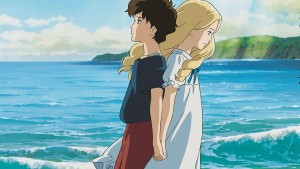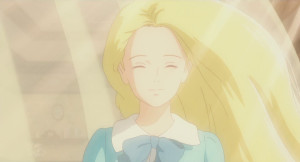 Review: One Night Only
Review: One Night Only
When Marnie Was There | Hiromasa Yonebayashi | Japan | 2014 | 103 min
UW Cinematheque, 4070 Vilas Hall, Saturday, September 5»
2:00pm (English dub) and 7:00pm (Japanese with English subtitles)»
The UW Cinematheque’s Fall 2015 Premiere Showcase kicks off with what will likely be the last feature released by Studio Ghibli. The ghost story melodrama When Marnie Was There is well worth seeing (and hearing) on the big screen for its many Ghibli hallmarks even if it doesn’t quite reach the heights of the studio’s best films.
It is no secret that the UW Cinematheque has had an ongoing love affair with Studio Ghibli, the Japanese animation studio best known for films by its founders, Hayao Miyazaki (My Neighbor Totoro, The Wind Rises) and Isao Takahana (Grave of the Fireflies, The Tale of Princess Kaguya). In addition to an extensive Ghibli series in 2013 (which I surveyed for Isthmus), back in January the Cinematheque showcased the not-so-great (but intriguing for fans) documentary The Kingdom of Dreams and Madness which provided behind-the-scenes footage of Miyazaki and Takahana working on their last films. Technically, the studio is on “hiatus,” but it is unlikely to resume producing feature films. The final feature produced by Studio Ghibli, When Marnie Was There, was released theatrically back in June (never making it to Madison) and will arrive to home video next month. Appropriately, the Cinematheque will kick off its Premiere Showcase this Saturday with one last embrace of Studio Ghibli and its legacy.
Hiromasa Yonebayashi’s When Marnie Was There is an adaptation of the 1967 children’s book by British author Joan G. Robinson (Miyazaki placed the book on his list of fifty recommended children’s books). The film transplants the action from the Norfolk countryside to rural, seaside Kushiro. Our heroine, 12-year-old Anna, is sent there for the summer by her foster mother, Yoriko, to recover from recent asthma attacks. But it is unclear whether her breathing problems have been triggered by the polluted Sapporo air or by her general anxiety and lack of self-esteem due to her perceived lack of a “real” family.
Anna stays in Kushiro with Yoriko’s relatives, Setsu and Kiyomasa Owia. Kiyomasa half-jokingly warns Anna to stay away from two nearby landmarks because of ghosts: an abandoned feed silo on top of a hill, and a dilapidated mansion across the salt marsh. Curiosity gets the best of Anna, however, and she investigates the mansion during low tide, only to be trapped there during high tide. As she is saved and rowed back to shore, Anna believes she can see lights on in the mansion windows. That night Anna dreams about a young blond girl in the mansion who has her hair brushed sternly by an older woman.
The Kushiro environment improves Anna’s asthma, but it doesn’t alleviate her social anxieties. She behaves awkwardly at the local Tanabata festival and recklessly calls the one girl she has met so far a “fat pig.” When Anna runs away in anger and frustration she discovers a rowboat that can take her across the marsh to the mansion again. This time she meets the blond girl, Marnie. Anna tells Marnie that she has seen her in her dreams, but Marnie assures Anna that she is not dreaming now. They both promise to keep their new friendship a secret, and Marnie introduces Anna to her world of formal mansion parties and misbehaving with the household staff.
It doesn’t take long to realize that Marnie functions as a psychological crutch for Anna to deal with her anxieties and self-esteem issues. When Marnie Was There works best during the lyrical, dream-like scenes that Anna and Marnie share together. Here the Ghibli house style kicks into full gear with attention to details and textures both visually and on the soundtrack.
 Vivid colors bring the rural landscapes to life, and soundtrack goes well beyond rudimentary foley effects to provide a unique sense of place. Outside, incidental activities on the water celebrate simple, natural movements. Inside, listen to the creaks and the room tone in the Owia home, then compare them to the unique, distinct and layered sounds in all of the other interiors. Attention to these details add to a rich viewing and listening experience.
Vivid colors bring the rural landscapes to life, and soundtrack goes well beyond rudimentary foley effects to provide a unique sense of place. Outside, incidental activities on the water celebrate simple, natural movements. Inside, listen to the creaks and the room tone in the Owia home, then compare them to the unique, distinct and layered sounds in all of the other interiors. Attention to these details add to a rich viewing and listening experience.
Character animation is also typically strong for a Ghibli feature, including small movements, gestures and postures that distinguish each character as individuals. Seemingly mundane movements help bring the world of the film to life; notice Setsu catch a cherry tomato as it falls from her plate, and observe Anna’s tomato cutting technique. Several sequences in When Marnie Was There are a pleasure to watch simply because they are designed and crafted by artists who love to observe and replicate movement.
In terms of dramatic storytelling, however, Marnie never quite solves the problem of conveying Anna’s psychological progress beyond linking it to her investigation of the real Marnie’s origins. Anna’s progress is a kind of “talking cure,” in which she needs to acknowledge to Marnie what is really bothering her before she can address those issues herself. Yonebayashi and his co-screenwriters understand which questions need to be answered to bring closure, but too often the questions are answered for Anna, instead of Anna answering them through her own agency.
Anna acknowledges to Marnie that she is upset that her foster mother Yoriko receives government support to take care of her, because she wonders if Yoriko would truly love her without the stipend. That acknowledgement is an important first step in Anna’s emotional progress, but equally important would be for her to bring the issue up with Yoriko, thus leading to a dramatically interesting scene. The eventual stipend discussion between Anna and Yoriko, however, undercuts the dramatic potential by having Yoriko coincidentally bringing it up, and brushing aside the issue’s emotional significance to Anna.
Anna’s movements between fantasy and reality aren’t always worked out smoothly or plausibly. When she is discovered after one fantasy sequence, she looks like a possible assault victim abandoned in the bushes. One begins to wonder how many times Anna will be found passed out and disheveled before Setsu and Kiyomasa at least discuss whether they should let her go out on her own so much. But they don’t, providing yet another example of the film’s avoidance dramatic conflict.
More importantly, the investigation into Marnie’s origins relies too heavily on verbal explanations rather than visual storytelling. Anna meets two people who help her figure out who the real Marnie is (or was). While sketching on the shore Anna meets a painter, Hisako, who is also drawn to the mansion across the salt marsh because of her childhood memories. Hisako informs Anna that a new family is moving into the mansion, and when Anna returns to the mansion in the daytime she meets the new owner’s daughter, Sayaka. Hisako and Sayaka initially provide small clues for Anna to put together (and, of course, the previously mentioned abandoned feed silo figures into the mystery). But at an important juncture Hisako simply tells Anna (almost) everything that she needs to know in an extensive expository flashback, again undermining Anna’s agency and dramatic interest.
 Marnie is most interesting when she seems full of contradictions and ambiguities. Once Hisako connects most of the dots, Marnie’s significance to Anna becomes far too overdetermined and far less compelling (and the audience can guess the remaining enigmas long before Anna does). While Anna’s discoveries have a significant emotional resonance for her, it is hard for the audience to empathize with her because script reveals too much too quickly in Hisako’s flashback after an initial deliberate pace. We share the same information, but we don’t really share Anna’s response to that information. The final and most significant reveal comes serendipitously from Yoriko (again, not Anna’s agency); but rather than providing a climactic emotional moment, the reveal makes the mystery seem somewhat contrived in the first place.
Marnie is most interesting when she seems full of contradictions and ambiguities. Once Hisako connects most of the dots, Marnie’s significance to Anna becomes far too overdetermined and far less compelling (and the audience can guess the remaining enigmas long before Anna does). While Anna’s discoveries have a significant emotional resonance for her, it is hard for the audience to empathize with her because script reveals too much too quickly in Hisako’s flashback after an initial deliberate pace. We share the same information, but we don’t really share Anna’s response to that information. The final and most significant reveal comes serendipitously from Yoriko (again, not Anna’s agency); but rather than providing a climactic emotional moment, the reveal makes the mystery seem somewhat contrived in the first place.
Anna’s remaining obstacles to closure in the village are equally undramatic. When she returns to the “fat pig” girl to apologize, it seems like a script machination rather than a reflection of Anna’s personal growth.
Shortcomings aside, there are many reasons to see Madison’s first public screenings of When Marnie Was There. When I’ve been asked whether kids will like other Ghibli films, I’ve answered, “Your smart kids will.” And most kids won’t have the same script objections I have suggested above. With Marnie Ghibli maintains its tradition of intelligently respecting the emotional lives of young female characters. As children’s entertainment and media continues to get louder and narrower in scope, it is refreshing to watch a quiet, intelligent, and emotionally engaging story about a young girl who is not a princess with something on her mind other than fashion and boys. And it is a great pleasure to share with children a film with visual texture, which seems to have vanished from American animated feature films (with the possible exception of Pixar). You don’t have to have a kid to appreciate these things, you just have to appreciate how rare films like this have become, and enjoy them when you have the opportunity to do so.
The Cinematheque will present two screenings of When Marnie Was There on Saturday, September 5. The first will be the English dubbed version produced by the North American distributor, GKids, at 2pm. The second will be the subtitled Japanese language version with English subtitles at 7pm. I only had the opportunity to preview the Japanese language version, but the English version features the voices of Hailee Steinfeld, John C. Reilly, Cathy Bates, and Geena Davis.